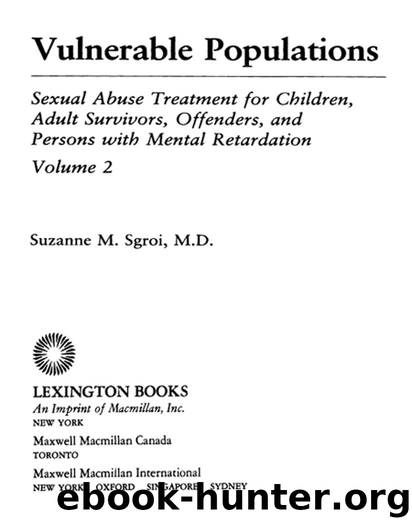Vulnerable Populations by Suzanne M. Sgroi

Author:Suzanne M. Sgroi
Language: eng
Format: epub
Publisher: Lexington Books
Published: 1989-07-15T00:00:00+00:00
8
Sexual Abuse Avoidance Training for Adults with Mental Retardation
Suzanne M. Sgroi
Judith A. Carey
Amy B. Wheaton
Society has been making radical changes in the way it views persons with mental retardation. For hundreds of years they were seen as an embarrassment, segregated from the community, and kept away in institutions. Beginning in the 1950s, society was challenged to change these views and see each person as a valuable human being capable of being part of the community, regardless of the level of disability or retardation.
From the 1970s to the present, there have been significant advancements in the integration, education, and training of children and adults who are mentally retarded within the community at large. Persons with mental retardation have begun to move back into local community settings in group homes, apartments, and other neighborhood residences. This process has had many labels—the principle of normalization and deinstitutionalization, to name two. Persons with retardation ranging from mild or moderate to severe retardation have begun to be educated and trained with their normally functioning peers.
The enactment in 1975 of Public Law 94–142, the Education for All Handicapped Children’s Act. expanded appropriate educational opportunities for children with retardation. Parental participation in the decision making about their children’s special educational and vocational needs increased collaboration efforts between home and school. Fewer children were being institutionalized, and those already in institutions were being placed in the community.
Vocational training programs have multiplied to prepare adults with retardation for sheltered and competitive community employment. Persons with mental retardation have begun to be recognized as stable and productive members of the community work force. This integration has enabled society to become more fully aware of the developmental potential of persons with retardation.
Today persons with mental retardation are viewed as individuals who have more in common with other human beings than they have differences. Their opportunities to live in and be a part of communities and to work, entertain themselves, and live their lives to the fullest have improved substantially. This is a credit to the advocates, parents, professionals, and legislators who have labored diligently to ensure that persons with mental retardation are afforded their constitutional rights and equal opportunity.
While much remains to be done, the lives of many of these person have changed qualitatively. This change has prompted policymakers to reflect on a range of issues from housing to employment, transportation, accessibility, and community resources, including theaters, recreation centers, and medical and dental care. These issues are not new; rather they are being raised from a fresh perspective.
Concurrently the reality of persons with retardation within the community has raised other philosophical issues: for example, the right to love others, to develop healthy emotional relationships, and to receive the necessary training and assistance to live appropriately and successfully in a complex society. All professionals, parents, and concerned persons are being challenged to enable the person with mental retardation not only to be in the community but to participate in life experiences to the fullest. Within the many facets of this challenge is the need for appropriate sex education, a daily lifelong learning program.
Download
This site does not store any files on its server. We only index and link to content provided by other sites. Please contact the content providers to delete copyright contents if any and email us, we'll remove relevant links or contents immediately.
Should I Stay or Should I Go? by Ramani Durvasula(6792)
The Lost Art of Listening by Michael P. Nichols(6478)
The Rosie Project by Graeme Simsion(5196)
We Need to Talk by Celeste Headlee(4876)
Beartown by Fredrik Backman(4425)
Suicide Notes by Michael Thomas Ford(4274)
Hunger by Roxane Gay(4228)
Ego Is the Enemy by Ryan Holiday(3999)
I Love You But I Don't Trust You by Mira Kirshenbaum(3231)
Mummy Knew by Lisa James(3172)
Crazy Is My Superpower by A.J. Mendez Brooks(2863)
Girl, Wash Your Face by Rachel Hollis(2825)
The Complete Idiot's Guide to Coping With Difficult People by Arlene Uhl(2824)
Toxic Parents by Susan Forward(2810)
Not a Diet Book by James Smith(2730)
The Hard Questions by Susan Piver(2555)
Name Book, The: Over 10,000 Names--Their Meanings, Origins, and Spiritual Significance by Astoria Dorothy(2494)
The Gaslight Effect by Dr. Robin Stern(2354)
The Social Psychology of Inequality by Unknown(2312)
